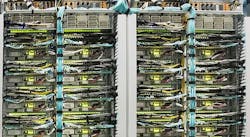Data Bytes: Enterprise Switch Sales Slow, But Hyperscalers Still Buying
Data Bytes is a weekly roundup of research and analysis for the data center and cloud computing sector. Want to get it in your Inbox every Monday? Sign up for our DCF news updates.
The Ethernet switch market has seen divergent trends during the COVID-19 pandemic, as stronger activity by service providers was offset by a drop in orders from enterprise customers, according to International Data Corporation (IDC). The research firm’s Quarterly Ethernet Switch Tracker reported $6.6 billion in revenue in the second quarter of 2020 (2Q20), a decrease of 6.3% year over year.
“Softness in the Ethernet switch market in the first quarter of 2020 continued into the second quarter, driven primarily by the continued impact of the COVID-19 pandemic, which led to the lockdown of most economies worldwide,” said Brad Casemore, research vice president, Datacenter and Multicloud Networks at IDC. “Despite the headwinds of COVID-19, the Ethernet switch market stayed relatively healthy, most notably because of steady demand from hyperscalers and other cloud providers, which continue to invest in greater datacenter scale and higher bandwidths.”
The trends were also heavily influenced by geography. “Regions of the world where the COVID-19 pandemic subsided in the second quarter saw increases in their markets, while the response to the virus was ramping up during this period in parts of Europe and the Americas, representing a headwind, said Petr Jirovsky, research director, IDC Networking Trackers.
The Ethernet switch market saw year-over-year reductions in most global regions. A bright spot was China, which recorded a 25.4% year-over-year increase in 2Q20. The broader Asia/Pacific region (excluding Japan and China) fell by 6.7% year over year with Hong Kong’s Ethernet switch market dropping 35.8%. Japan’s market was off 3.0% from a year earlier.
There was also weakness across Europe and the Americas. Western Europe’s Ethernet switch market fell 13.1%, with the United Kingdom off 23.4% from a year earlier and France losing 20.5%. Central and Eastern Europe was down 7.6% with Hungary losing 20.1% year over year while the Czech Republic grew 17.6%. The Middle East and Africa region fell 7.5% with Qatar declining 17.1% but Israel gaining 7.6%. In the Americas, the United States was down 12.5% while Canada lost 16.5%. The Latin America region fell 22.1% with Mexico losing 21.6% compared to a year earlier.
Growth in the Ethernet switch market continues to be driven by the highest-speed switching platforms. For example, port shipments for 100Gb switches rose 51.2% year over year to 6.7 million units. 100Gb revenues grew 16.3% year over year in 2Q20 to nearly $1.5 billion, making up 22.4% of the market’s overall revenue. 25Gb switches also saw impressive growth with revenues increasing 39.0% to $505.9 million and port shipments growing 62.2%. Lower-speed campus switches, a more mature part of the market, saw mixed results in port shipments and revenue as average selling prices (ASPs) in this segment continue to decline. 10Gb port shipments rose 23.1% year over year, but revenue declined 6.1%. 10Gb switches make up 28.0% of the market’s total revenue. 1Gb switches declined 10.1% year over year in port shipments and fell 17.9% in revenue. 1Gb now accounts for 35.0% of the total Ethernet switch market’s revenue.
Among vendors:
- Cisco finished 2Q20 with a 13.4% year-over-year decline in overall Ethernet switch revenues and market share of 47.2%. In the hotly contested 25Gb/100Gb segment, Cisco is the market leader with 35.7% of the market’s revenue. Cisco’s combined service provider and enterprise router revenue was down 9.6%, with enterprise router revenue decreasing 11.8% and SP revenues down 8.1% year over year. Cisco’s combined SP and enterprise router market share stands at 33.2%.
- Huawei’s Ethernet switch revenue rose 15.7% on an annualized basis, giving the company market share of 12.0%. The company’s combined SP and enterprise router revenue increased 16.7% year over year, giving the company a market share of 36.3%.
- Arista Networks saw Ethernet switch revenues decline 17.9% in 2Q20, bringing its share to 6.4% of the total market. 100Gb revenues account for 72.4% of the company’s total revenue, reflecting the company’s longstanding presence at cloud providers and large enterprises.
- HPE’s Ethernet switch revenue declined 17.3% year over year, giving the company a market share of 5.1%.Juniper’s Ethernet switch revenue fell 8.2% in 2Q20, bringing its market share to 2.8%.
- Juniper saw a 3.3% decline in combined enterprise and SP router sales, bringing its market share in the router market to 10.2%.
About the Author



